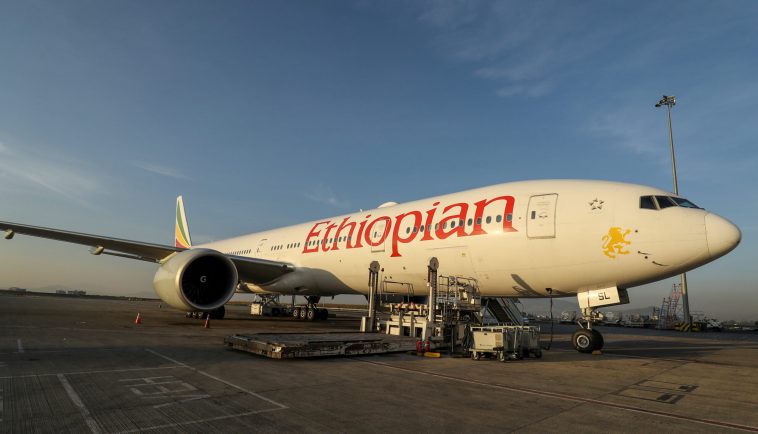The Covid-19 pandemic hit the aviation sector hard with global cumulative losses reaching €103bn ($125.9bn), out of which €1.6bn was incurred by African airlines.
Ethiopian Airlines CEO, Tewolde GebreMariam, says the company “demonstrated agility, quick decision-making and resilience that have helped” in the face of falling passenger traffic, which, in Africa, registered a 69% drop in 2020 compared to figures from the previous year.
The airline is now the first on the continent to test the International Air Transport Association (IATA) health passport.
At the peak of the crisis, the company prioritised air cargo business: 25 refitted passenger aircraft joined the existing fleet of 12 cargo planes, Tewolde told The Africa Report.
This is a growing sub-sector, and demand is already 9% higher than before the crisis. “Ethiopian Airlines took a conscious decision to develop both its passenger and cargo business. So even before Covid-19, Ethiopian’s cargo business was solid and growing very fast,” says Raphael Kuuchi, consulting director for legal, industry and government affairs at the African Airlines Association (AFRAA).
Vaccine hub for Africa
This model has enabled the airline to transport medical supplies, and it continues to be a partner of choice for the World Health Organisation, the United Nations and the Chinese giant Alibaba in the global distribution of Covid-19 vaccines.
“By the start of May 2021, Ethiopian Airlines had transported more than 20 million doses of vaccine to more than 20 countries,” says Chiedza Madzima, a research and operational risk manager at Fitch Solutions.
“Ethiopian is also developing an in-house dry-ice manufacturing facility that will seek to address the need for additional coolants and ultra-cold environments for the storage and transport of vaccines.” Madzima points out that these developments “will also provide long-term benefits for the development of domestic and regional cold chains – benefitting sectors such as horticulture, agribusiness and healthcare”.
Romuald Ngueyap, founder of the website NewsAero, says Ethiopian “is positioning itself on the corridor between Asia and the African continent, where it has the largest share of traffic. That makes Ethiopian strong.”
In 2020, the company transported 54,400 tonnes of cargo to and from Guangdong airport in China. This included medical equipment, industrial products, electronics and computer equipment. “It’s a triangular operation: Africa, Europe, China, and then Africa again, mobilising more than 50 planes per week,” says Tewolde. “Covid-19 has had a positive impact [on Ethiopian’s activities in Asia].”
The airline also flies cargo from West Africa to South America, and from Europe to the United States, including clothes made for Zara (Inditex). “Ethiopian was already carrying out logistics from South America to Asia. They’ve done similar operations from Asia to Europe and from Asia to Africa. It has broadened their scope, and this has made other business partners look at it as a solid partner,” says AFRAA’s Kuuchi.
According to the Ethiopian Airlines CEO, the company has gone through the worst year ever experienced by the industry “without layoffs or salary cuts”, meeting all its financial obligations (maintenance loans, aircraft leasing, salaries) without additional support from the state, its 100% shareholder.
Fingers in many pies
Buoyed up by its performance during the crisis, the airline is on the lookout for new opportunities in Africa. In some cases it has come to the aid of other airlines.
Last October, the airline offered operational assistance (pilots, maintenance and aircraft) to troubled national carrier South African Airlines (SAA) in a joint venture. SAA has since received a government grant of $641m and is reportedly close to concluding an agreement with an investor.
Ethiopia’s national carrier already has stakes in Chadian Airlines (49%), Zambia Airways (45%) – whose relaunch was postponed until at least the end of 2021 – Malawi Airlines (49%) – which is facing liquidation – and Ethiopian Mozambique Airlines (99%) – which has been forced to suspend flights.
Asky Airlines, based in Lomé, Togo, appears to be less compromised, but has turned to Ethiopian Airlines and other shareholders (Ecobank, Banque Ouest Africaine de Développement and ECOWAS Bank for Investment and Development) for financial assistance.
“Some companies will go bankrupt, others will recover with difficulty, but we are also seeing the creation of start-ups,” says Ngueyap, the aviation journalist.
“Currently, the price of aircraft is low, and airports, whose traffic has declined, have taken initiatives to encourage companies that want to come to them. This is the case in Nigeria, for example.”
Ethiopian’s maintenance centre and aviation academy could thus see new customers arrive, in addition to those preparing to return to service.
A digital future
Ethiopian Airlines, which announced in 2018 that it had reached the goals of its ‘Vision 2025’ plan seven years ahead of schedule, has been working on digitising its operations. The company invested more than $40m between 2015 and 2020 to increase online sales.
After launching a mobile app in 2018, the airline is now the first on the continent to test the International Air Transport Association (IATA) health passport. However, renewed competition could come from Egypt. EgyptAir has invested heavily in its fleet, with the purchase of 15 Airbus A320s in 2020 and signing of a $6bn contract to buy 54 Boeing aircraft in 2018.
Although the Egyptian company is experiencing financial difficulties, it obtained a $130m loan from Cairo in January. Eager to develop its African activities, the airline recently signed an agreement with Sudan Airways (for operational assistance), and Ghana (for creation of a national airline). It remains to be seen whether this deal could unseat Ethiopian Airlines.

